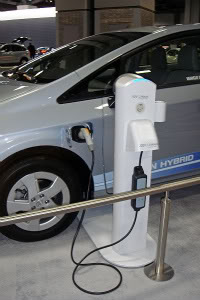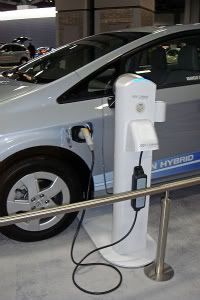Aker-Wade: Leading the Way to Fast-Charging Solutions for Electric Vehicles

I just got off the phone with John Aker, CEO of Aker-Wade Inc. in Charlottesville, VA, a leader in Level Three (fast-charging) solutions for electric vehicles. Obviously, the establishment of a solution for charging away from the home and workplace is a necessary condition to the widespread adoption of EVs. Until we can get a charge in about 15 minutes (preferably 10) that provides a range of a couple of hundred miles, there will always be a need for gas and diesel.
John’s solution, fast-charging (400 volts and 125 amps, or about 50 kilowatts) enables a Nissan Leaf owner to go from 20% state of charge to 80% in about 20 minutes. This is good, but he sees a day in the not-too-distant future in which batteries will improve and become larger, eliminating any need for gasoline-powered passenger cars.
From your lips to God’s ears, my friend.


The American public is addicted to driving as much as to oil. This will change as gas goews higher. But I believe that Level III charging only supports this addiction. What nobody has published is what is Level III charging going to cost the EV driver? Level III chargers are estimated to cost $50,000 to buy and install including finding the infrastructure for 480 V 3-phase power. Let’s take John’s example – the Leaf has a 24 kWh pack and 20%-80% is 60% of 24 or 14.4 kWh. That represents about $4.75 of electricity at home ($,011/kWh). If the provider marks that up 10x = $47.50 for your 20 minute charge; they make $42.75. They need 1170 people to charge to break even. I doubt at 10x they will get many users. At 2x market up your charge is is $9.50 and they need 10,526 people charging to break even- THAT DOG DON’T HUNT!
I can see only in an emergency would anyone use this. And as said above as batteries get better, the need will drastically drop
Just like the parts needed to build a productive fast computer are: Fast Hard Drives (Or now: Solid State Drives); Fast Video; and a Fast CPU/Motherboard System; the reduction of the performance of any of these elements slows the whole system. In the world of Electric Cars, the issues are Cost, Range, and Speed of Charging. If you can buy a car for $15,000, but it only goes for 20 miles all electric, and that’s it – it does not matter how fast it can charge, in spite that it’s cheap; similarly – if it will go 500 miles on a charge, and charges in 10 minutes, but cost the same as gas to charge it, or costs $300,000 to buy it – all bet’s are off (as far as mass adoption is concerned)!
The Issue with Charging Speed – in part is the opportunity to charge everywhere you park for more than 30 minutes, on the one hand, and in every place you will be traveling, in the other! So – Level 3 Chargers, placed on the Interstate, at Service Centers, could not handle the flow rate of an 8-pump Gas Station at present, but – the good news is – they don’t need to, and won’t need to for any time in the next 3-5 years; maybe even for the next 10 years, as EV’s from OEM’s gradually ramp up, and people start singing the praises and Range anxiety (Thank you GM for that Scary Catch Phrase) begins to fade as more and more people see EV’s in traffic, and not on Tow Trucks!
If your EV range = 2 days of your usual driving needs, and you can charge at Home, at Work, at the Mall, at the Gym, at the Theatre and the Restaurant, at the Pharmacist, the Doctors Office, The Little League baseball Field, at every other Car Wash or Gas Station, or every 5 miles or 5 minutes of driving apart – Then I think the issue of Level 3 Fast Charging will dwindle.
We already have the usual OEM EV able to deliver about 50 – 80 miles of pure EV Driving, some able to deliver 150 – 200 miles of decent driving performance, and soon to be delivered are cars with a range of 250 – 300 miles with general driving capabilities – with today’s Lithium Ion Cells! Each and everyone of these components specs are being improved – so that within the decade – these base ranges – in the same cars, will be 30% – 50% to – in some cases – 100% Farther range per charge, as we take the new cells with 2.5X – 3X the energy density of current cells – out from the Lab testing and into production!
So The interesting thing then remains – Cost! The latest figures I have seen are 25% of the cost, but with about 3X the Energy Density! The only issues are – will early adopters keep the lines running, or will they go into a stall, and ‘weight’ for the next generation of Cells and EV’s to come along?